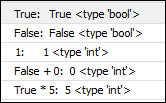In contrast to the dozens of integer types in IEC or C, there is only one integer type in Python. Integer types in Python do not have a fixed size. Instead, they grow as needed and are limited only by available memory.
Example: Integers.py
from __future__ import print_function i = 1 print(i) j = 0x1234 # hex number, is 16#1234 in IEC and 4660 in decimal k = 0o123 # octal number, is 8#123 in IEC and 83 decimal l = 0b101010 # binary number, is 2#101010 in IEC and 42 in decimal print(j, k, l) m = (2 + 3)*10 # k is 50 now print(m) n = 10 ** 100 # 10 to the power of 100 print(n)
Resulting output:

There is also only one floating-point type in Python which is similar to the IEC data
type LREAL. It provides 64-bit IEEE floating point arithmetic.
The syntax is like C-based languages for the most part:
Example: Floating-point types
# A simple float... a = 123.456 # A float containing the integral value 2 b = 2. # Leading zeroes can be left off c = .3 # same as 0.3 # Exponential / scientific representation d = -123e-5
Two special cases are True and False, two constants that define the Boolean truth values. They behave similar to the integer
values 0 and 1, except when they are converted into strings and return their names.
Example: Booleans.py
# booleans behave like integers, except when converted to strings.
# The built-in function "type" can be used to query the type of a value.
print("True: ", True, type(True))
print("False: ", False, type(False))
print("1: ", 1, type(1))
print("False + 0: ", False + 0, type(False + 0))
print("True * 5: ", True * 5, type(True * 5))
Resulting output:

